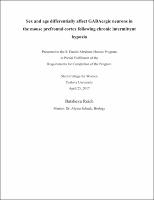Please use this identifier to cite or link to this item:
https://hdl.handle.net/20.500.12202/3997Full metadata record
| DC Field | Value | Language |
|---|---|---|
| dc.contributor.author | Reich, Batsheva | - |
| dc.date.accessioned | 2018-10-18T15:37:34Z | - |
| dc.date.available | 2018-10-18T15:37:34Z | - |
| dc.date.issued | 2017-04-25 | - |
| dc.identifier.uri | https://hdl.handle.net/20.500.12202/3997 | - |
| dc.identifier.uri | https://ezproxy.yu.edu/login?url=https://repository.yu.edu/handle/20.500.12202/3997 | |
| dc.description | The file is restricted for YU community access only. | en_US |
| dc.description.abstract | Obstructive sleep apnea, a sleep disorder known to cause airway blockage and inability to breathe during the night, has been associated with a decrease in Gammaaminobutyric acid (GABA) measured using msing proton magnetic resonance spectroscopy ( 1 H MRS) in the prefrontal cortex of the human brain, a region associated with executive function. This study aimed to obtain a fuller understanding of the mechanisms behind the human finding by investigating GABA content in the brains of hypoxic mice. Characterized by deprivation of sufficient oxygen supply, hypoxia is one of the major symptoms in obstructive sleep apnea. In fact, chronic intermittent hypoxic mouse models are often used to study aspects of obstructive sleep apnea. | en_US |
| dc.description.sponsorship | S. Daniel Abraham Honors Program | en_US |
| dc.publisher | Stern College for Women | en_US |
| dc.rights | Attribution-NonCommercial-NoDerivs 3.0 United States | * |
| dc.rights.uri | http://creativecommons.org/licenses/by-nc-nd/3.0/us/ | * |
| dc.subject | Mice -- Research | en_US |
| dc.subject | Respiratory insufficiency | en_US |
| dc.subject | Sleep disorders | en_US |
| dc.title | Sex and age differentially affect GABAergic neurons in the mouse prefrontal cortex following chronic intermittent hypoxia | en_US |
| dc.type | Thesis | en_US |
| Appears in Collections: | S. Daniel Abraham Honors Student Theses | |
Files in This Item:
| File | Description | Size | Format | |
|---|---|---|---|---|
| Batsheva-Reich.pdf Restricted Access | 2.55 MB | Adobe PDF |  View/Open |
This item is licensed under a Creative Commons License

